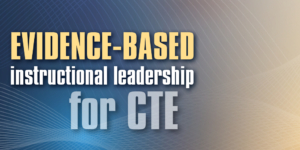Lead with evidence to support instruction
Instructional leadership in career and technical education (CTE) must be transformational. Leaders are tasked with creating solutions based on problems, questions, and needs and developing processes that work for their schools, districts, and regions. Their role is multifaceted and complex. One end of a CTE leader’s work is anchored in developing the knowledge and skills of their teachers. And on the other end, the need to ensure students are prepared to enter the workforce.
CTE teachers bring a wealth of experience into the classroom, having taken many different approaches to professional teacher preparation. Likewise, students have varying backgrounds, understandings and motivations for taking CTE courses.
“How can we develop instructional leadership strategy in a way that will positively affect student learning?” Researchers have proposed that we must focus on three critical elements: changing views of learning, sharpening teachers’ instructional knowledge, and enhancing students’ knowledge and abilities related to academic and industry standards (City et al., 2009). These three themes may provide evidence-based direction for CTE leaders. This article illuminates how to promote the instructional core by making clear connections to how students learn best.
Apply strategies of effective student learning.
The cognitive sciences help explain the conditions needed to create optimal environments according to how students learn best (National Academies of Sciences, Engineering, and Medicine, 2018; National Research Council, 2000). Three key components are critical in changing how we view instructional leadership.
Learner
The most effective lessons are not just informational. They are experiences that deeply embed concepts, evoking questions and curiosity and fostering a sense of lifelong learning.
Knowledge
In knowledge-centered classrooms, students should know how ideas connect and scaffold. Clear standards are set for what students should learn, and industry establishes fundamental theoretical and practical knowledge.
Assessment
Assessment-centered classrooms prioritize high learning standards and provide frequent feedback. Feedback comes in various forms, helping students self-monitor their progress at every stage. It is an ongoing dialogue, a constant navigation toward improved understanding.
Develop high-quality instructional materials.
We must ensure that we use instructional approaches derived from cognitive science research.
Design clear, coherent units of instruction.
Understanding by Design (UbD) procedures can help educational leaders identify lesson and unit learning outcomes related to science, engineering, technology and mathematics (STEM). UbD emphasizes that units should focus on goals that specify what students should do with their learning in the long run (Wiggins & McTighe, 2005). Using UbD, we can create more coherent instructional units.
Activate student thinking.
Opportunities to apply CTE skills and knowledge in real-life circumstances can help situate learning. Asking about their ideas and experiences can help focus students’ attention and creates a “need-to-know” situation for learning (McTighe & Willis, 2019). For example, leaders can use problem- and needs-based scenarios to spur student thinking before tackling projects and teaching procedures.
Promote crosscutting concepts.
This can help take rote learning activities to a deeper conceptual level. For example, CTE teachers should explicitly teach procedures and safety, but students may also benefit from thinking about patterns (a crosscutting concept) that exist when using different equipment. They gain more sophisticated knowledge when they think about cause-and-effect relationships (a crosscutting concept) between the actions they perform and the implications. And they develop deep conceptual understanding when they think about scale, proportion and quantities (a crosscutting concept) (NGSS Lead States, 2013).
Encourage visible thinking.
Providing ample and ongoing opportunities to think about their learning can help students become more independent problem-solvers (National Research Council, 2000). Leaders can promote specific strategies with teachers to share with their students. Consider the following examples.
- Accurate self-assessments: “How well did I perform?” “What was most difficult?”
- Reflections on learning: “What was most interesting or surprising about this (topic or project)?” “What strategies worked well for me during this learning experience?”
- Goal setting: “What will I try next time to improve?”
Infuse literacy in CTE practices.
Make connections between CTE and other areas explicit. The reading associated with CTE offers some of the most complex technical information students will encounter. And thus students may develop advanced reading skills.
These key instructional design elements place students at the center of learning. They must be incorporated regularly in our classrooms, in our professional learning communities, and in our schools and districts. If we build these ideas into our instructional leadership strategies, we can expect to profoundly impact student motivation, learning and achievement by building teachers’ collective efficacy (Hattie, 2023).
Pat Brown, Ph.D., is the executive director of STEM and CTE for the Fort Zumwalt School District in St. Charles, Missouri. He has a range of K–12 and postsecondary teaching experience. Known for his scholarship on instructional approaches that place students at the center of learning, Brown makes frequent presentations at international, regional and state conferences. He is the author of Instructional Sequence Matters, a best-selling book series from the National Science Teaching Association.





